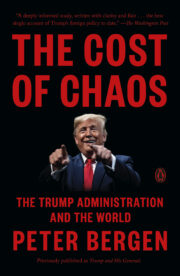With the twice-indicted former President Donald Trump still leading the race for the GOP presidential nomination, his possible return to the White House in 2025 can’t be discounted. Which raises the question: Who would Trump bring back into his orbit should there be a second Trump term?
By Trump’s own account, high on that list would be his former national security adviser, retired Lieutenant General Michael Flynn..
At a “ReAwaken America Tour” event held at the Trump National Doral Hotel in Miami in May, where Flynn was the headliner, Trump called in to tell Flynn, “You just have to stay healthy because we’re bringing you back. We’re gonna bring you back.”
Based on Flynn’s tight embrace of the Christian nationalist right and wild conspiracy theories, were Flynn to be brought back into a senior national security role in a possible second Trump administration, the US would be in for quite a scary ride.
Flynn, who had served with distinction in the post-9/11 wars in Afghanistan and Iraq, was a key supporter of Trump early on during his 2016 presidential campaign, when much of the Republican national security establishment had publicly declared their opposition to Trump.
Flynn was handsomely repaid by Trump when he won the 2016 presidential election, gaining the critical position of national security adviser.
Flynn wouldn’t last there long. He lied to then-Vice President Mike Pence about a conversation he had with the Russian ambassador before the Trump administration had assumed office, and he was defenestrated from the White House within three and half weeks, earning him the distinction of being the shortest-serving US national security adviser ever.
Flynn also lied to FBI officials about those discussions with the Russian ambassador and later pleaded guilty to lying to the FBI, but Trump pardoned him as he left office in late 2020.
Around this time, Flynn became part of a cabal of advisers to Trump who were trying to overturn the 2020 election during his final days in office. In an interview Flynn gave to Newsmax TV, he advocated seizing voting machines from around the US and deploying the military in swing states that had voted for Joe Biden.
At a wild meeting at the White House with Trump on December 18, 2020, Flynn again called for the seizure of voting machines. For a decorated three-star general who had once sworn an oath to uphold the Constitution, it seemed that Flynn had gone over the edge.
Today, Flynn has also reinvented himself as a star of the Christian nationalist right and regularly tours the country as a headliner with the “ReAwaken America Tour.”
These two-day marathons of preaching and politics have convened in more than a dozen states since launching in 2021, drawing audiences that organizers say number in the thousands in-person and many more online.
The onstage messaging offers a sharply drawn window into Christian nationalist ideology that makes “an apocalyptic call to a shrinking cohort to defend a fading vision of America as a white Christian nation.” That’s according to the book “Taking America Back for God,” a 2020 study of Christian nationalism by sociologists Andrew Whitehead and Samuel Perry.
Although Flynn himself is reported to have privately rejected the QAnon conspiracy movement as nonsense, Christian nationalists, as a whole, are quite susceptible to QAnon conspiracy beliefs, according to research by Paul Djupe and Jacob Dennen of Denison University. They found that around three-quarters of Christian nationalists they surveyed agreed with the QAnon conspiracy view that “Within the upper reaches of government, media, and finance, a secretive group of elites are thwarting Donald Trump’s efforts at reform, fomenting street violence, and engaging in child trafficking and other crimes.”
Recent national surveys suggest that about 20% of the US population embraces some Christian nationalist ideas. That is, they agree or strongly agree with statements such as “the federal government should declare the US a ‘Christian nation….’”
The “ReAwaken America Tour”
The ReAwaken America crowd looks to be a highly energized vanguard within this population. And Flynn is placing himself right at the center of it.
The ReAwaken America Tour is the brainchild of Clay Clark, a former wedding DJ and serial entrepreneur in Oklahoma, who says he had something like a conversion experience when he met Flynn at a political event and, as a result, decided to start holding conferences starring the retired general.
For an Audible podcast that we produced about Flynn and his role in ReAwaken America, Clark told us he considers Flynn “to be kind of like a father figure to [him],” and he hopes that Flynn will be Trump’s vice-presidential candidate.
On tour, Flynn is dubbed, without irony, “America’s general,” and, at the event we attended in May, America’s general was the unquestionable star of the show. Standing on stage at a podium flanked by jumbotron TVs draped with red Trump flags, Flynn told the crowd—many of whom had paid hundreds of dollars for tickets for the event, not to mention the price of bedding down at the Trump resort—that there was a conspiracy to take over the world.
According to Flynn, this conspiracy is led by… the World Economic Forum. Shouting into his mic, Flynn asserted, “The World Economic Forum. I know some of these people. And you can listen to what they say and watch what they do. There’s going to be forces, I mean, big, big forces. They’re going to try to pull this country towards the darkness.”
The World Economic Forum is best known for its annual gabfest held every winter in Davos, Switzerland, where heads of state and big macher CEOs gather in the snow-covered Alps to glad-hand and listen to deadly serious talks about the state of the world. Pretty dull stuff, but for Flynn and his acolytes at the ReAwaken America Tour, the World Economic Forum and its founder, the German economist Klaus Schwab, have a secret plan to purportedly take over the world known as the “Great Reset.”
“The Great Reset”
This phrase does indeed come from Schwab, who co-authored a book in 2020 about something he called the Great Reset, which was mostly just observations about how the Covid-19 pandemic had caused havoc around the world — along with some vague suggestions about how how governments and businesses can plan for a more resilient and inclusive world.
Yet, the organizers of the ReAwaken American Tour on the outer fringes of the right wing think that the Great Reset isn’t just a description of the state of the world, but is an actual conspiracy to take over the world. And in this narrative, global elites deliberately imposed Covid-19 lockdowns to destroy the world economy as part of a plan to bring about a socialist world government.
When we asked Clark how Schwab, an 85-year-old German academic, was going to take over the globe, Clark took a pass, saying, “ I don’t know that because I’m not thankfully hanging out with Klaus Schwab.”
Flynn and his supporters have a plan to remake the GOP in their image from the bottom-up and to take over county-level Republican organizations, boards of elections and school boards.
At a meeting kicking off the Miami conference, Flynn spelled out that plan. “Local action has a national impact. You get involved in your school board, your county commissioners, or elections…and you get in there, and you mix it up, and you fight.”
Flynn describes this struggle as a war. At the same Miami event, he said, “I have fought these bastards around the world, OK? And, the worst battles I have – sadly, sadly – the worst battles, the worst war that I am involved in is in my own country.”
Flynn says he’s at war in his own country. And it looks like he’s trying to muster an army.



